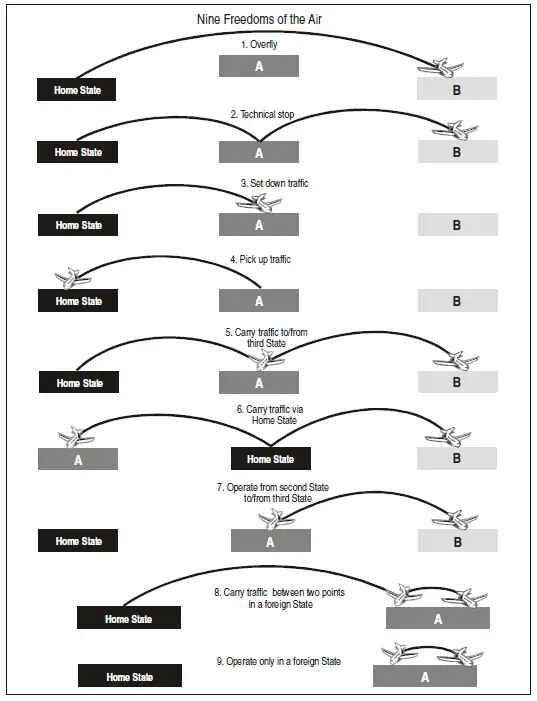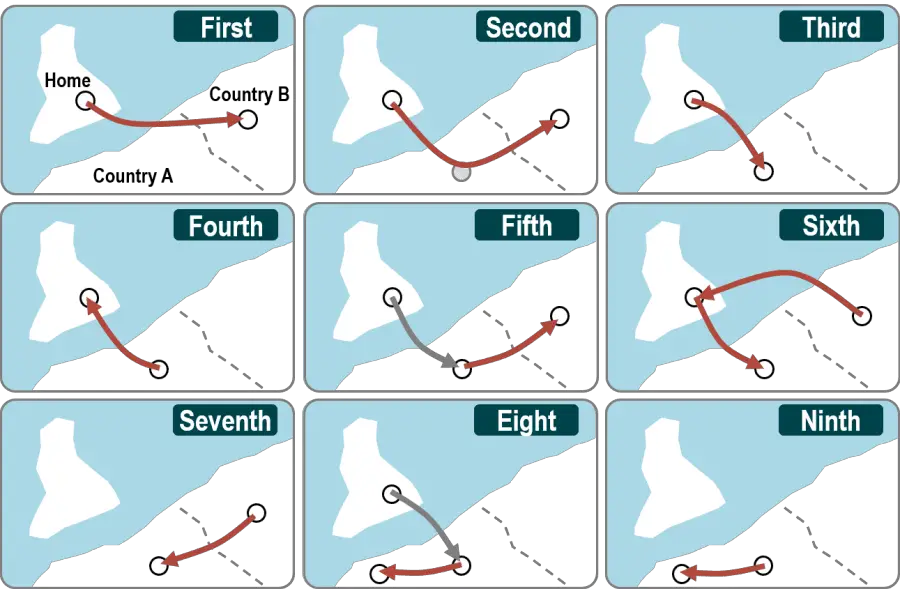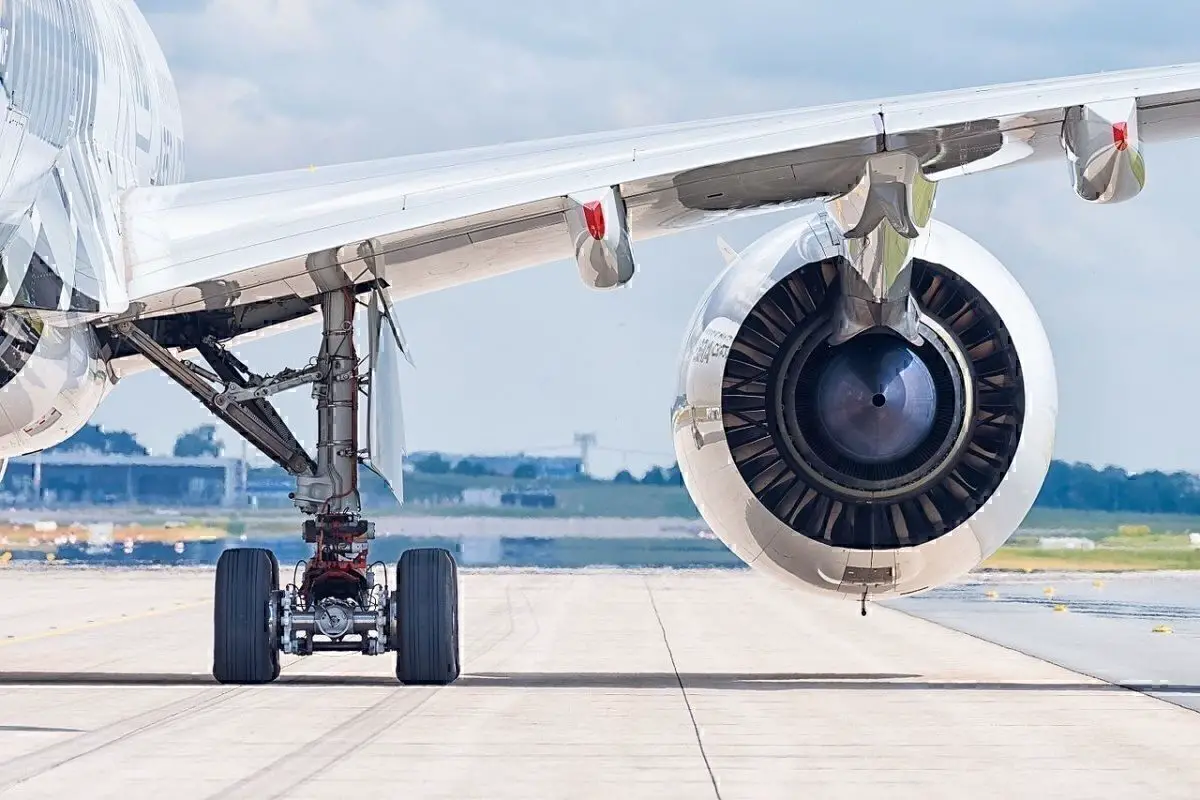
Freedoms of the Air
The Freedoms of the Air are a set of international aviation rights that govern airspace usage and commercial airlines’ ability to operate in foreign countries. These rights were established during the 1944 Chicago Convention on International Civil Aviation and have since been refined through various bilateral and multilateral agreements. The Freedoms of the Air are essential for the functioning of the global aviation industry, ensuring that airlines can operate in a transparent, predictable, and equitable manner.
Are There Five or Nine Freedoms of the Air?
While there are traditionally five freedoms of the air, a total of nine have been recognized over time. The first five freedoms are most commonly referred to and form the basis of most air services agreements. The additional four freedoms are less common and pertain to more specific situations. The nine freedoms of the air are as follows:
- First Freedom: The right to fly over a foreign country without landing.
- Second Freedom: The right to land in a foreign country for technical purposes, such as refueling or maintenance, without picking up or dropping off passengers or cargo.
- Third Freedom: The right to fly from one’s own country to another country.
- Fourth Freedom: The right to fly from another country back to one’s own country.
- Fifth Freedom: The right to fly between two foreign countries while originating or ending in one’s own country.
- Sixth Freedom: The right to carry passengers or cargo between two foreign countries, with a stopover in one’s own country.
- Seventh Freedom: The right to operate flights between two foreign countries without continuing to or originating from one’s own country.
- Eighth Freedom: The right to carry passengers or cargo within a foreign country, continuing from or on to one’s own country (also known as cabotage).
- Ninth Freedom: The right to operate flights entirely within a foreign country without continuing to or originating from one’s own country (also known as “stand alone” cabotage).

Image source: ICAO
Who is Entitled to Exercise the Freedoms of the Air?
The Freedoms of the Air are granted to airlines based on bilateral or multilateral agreements between their home countries and the countries they wish to operate in. These agreements, often called air services agreements (ASAs), outline the specific rights and privileges that each country’s airlines have when operating in the other country’s airspace. ASAs are negotiated between governments and can vary in scope and complexity, depending on the countries involved and the specific freedoms they wish to grant.
How do the Freedoms of the Air differ from Open Skies agreements?
While both the Freedoms of the Air and Open Skies agreements pertain to international aviation rights, they differ in scope and purpose. The Freedoms of the Air are a set of specific rights that govern the operation of commercial airlines in foreign countries. In contrast, Open Skies agreements are broader, aiming to liberalize the international aviation market by removing restrictions on routes, capacity, and pricing.
Open Skies agreements often include provisions that grant the first through fifth freedoms, but they can also encompass additional rights and privileges, such as the freedom to establish air transport services without prior government approval. In essence, Open Skies agreements promote a more competitive and open international aviation market, while the Freedoms of the Air provide a framework for airlines to operate internationally within agreed-upon parameters.
Do Airlines Need to Apply for It?
Airlines must obtain the necessary rights and permissions to exercise the Freedoms of the Air through their respective governments. This process typically involves applying for route approvals, traffic rights, and other permissions from the relevant aviation authorities in both the home and destination countries. These authorities will then consult the applicable air services agreements (ASAs) to determine if the requested freedoms are permissible under the terms of the agreements.
Once the necessary permissions have been granted, airlines may also need to obtain operating licenses, safety certificates, and other regulatory approvals to ensure compliance with the destination country’s aviation regulations. This process can be complex and time-consuming, often involving coordination between multiple government agencies and adherence to numerous international standards and requirements.
Are the Freedoms of the Air the Same in Every Country?
No, the specific Freedoms of the Air granted to airlines can vary significantly between countries, depending on the terms of their bilateral or multilateral air services agreements. Some countries may grant a more extensive range of freedoms, while others may impose restrictions or limitations on certain rights, such as limiting the number of flights, capacity, or the types of aircraft that can be operated on specific routes.
Additionally, some countries may choose to enter into more liberal Open Skies agreements, granting airlines greater flexibility in routes, capacity, and pricing. However, these agreements are not universally adopted, and the specific rights and privileges granted to airlines will depend on the agreements in place between their home country and the countries they wish to operate in.
Can Airlines be Granted Different Freedoms of the Air for Different Routes or Destinations?
Yes, airlines can be granted different Freedoms of the Air for different routes or destinations, depending on the terms of the applicable air services agreements.
For example, an airline may have the right to exercise fifth freedom rights on a specific route between two foreign countries but may only have third and fourth freedom rights on another route. The specific freedoms granted to an airline can also depend on factors such as market demand, competition, and the strategic interests of the governments involved in the agreements.
Are the Freedoms of the Air Exclusive to Commercial Airlines?
While the Freedoms of the Air primarily apply to commercial airlines, they can also be relevant to other types of air transport services, such as cargo operations, charter flights, and air ambulance services.
However, the specific rights and privileges granted to these operators may differ from those granted to commercial airlines and will depend on the terms of the applicable air services agreements and the regulatory framework in place in the countries involved.
How Have the Freedoms of the Air Evolved Over Time?
The Freedoms of the Air have evolved considerably since their inception at the 1944 Chicago Convention on International Civil Aviation. Initially, only the first five freedoms were recognized, but as the global aviation industry grew and evolved, additional freedoms were introduced to address new market dynamics and operational scenarios.
Over time, bilateral and multilateral air services agreements have become more complex and varied, reflecting the changing needs and priorities of the global aviation industry. Many countries have also entered Open Skies agreements, aiming to liberalize the international aviation market and promote increased competition and connectivity.
Despite these changes, the Freedoms of the Air remain a fundamental aspect of international aviation, providing a framework for airlines to operate across borders and ensuring the continued growth and development of the global aviation industry.
Final Thoughts
The Freedoms of the Air play a vital role in shaping the international aviation landscape. These rights have facilitated the growth of the global aviation industry by enabling airlines to operate across borders in a transparent, predictable, and equitable manner.
As the industry continues to evolve, the Freedoms of the Air are likely to undergo further refinement and adaptation to meet new market dynamics and operational scenarios. However, their fundamental importance in promoting connectivity and driving economic growth through air transport is unlikely to diminish any time soon.
The Freedoms of the Air are a set of international aviation rights that govern airspace usage and commercial airlines' ability to operate in foreign countries. ...
The freedoms of the air are a set of commercial aviation rights granting a country’s airline the privilege to enter and land in another country’s airspace, ...
Freedoms of the air are economic and diplomatic protocols agreed to by States for the commercial flow of revenue traffic by air. They are not to be confused ...
Most nations of the world exchange first and second freedoms through the International Air Services Transit Agreement. The other freedoms of the air, when ...
Freedoms of the air are not automatically granted to an airline as a right; they are privileges that have to be negotiated and can be the object of political ...
What are the five freedoms of Aviation and why are they important? Fundamentally, the freedoms of the air are the internationally standardized building blocks ...
Without The Nine Freedoms Of The Air your airline would not be allowed to fly you to a foreign country or fly over another nation's airspace. The Nine Freedoms ...
If you’ve never heard the term "fifth-freedom flights," you might be missing out on a lucrative way to snag a deal or use your frequent flyer miles. But to ...
Can an Airline Simply Fly Anywhere? Not at all. There are several obstacles to be taken care of if an airline wants to commence service between its country of ...
What’s important to remember is how much cooperation, at every level, goes into making international travel work. Freedoms of the Air set a framework to make ...
Nowadays, international flights are nothing out of the ordinary. Yet ensuring that airlines can fly into the sovereign airspace of other countries requires ...
Freedoms 3, 4, and 5 are essentially commercial privileges that encourage economic enterprise in the air. Freedoms 1 and 2 attack the political hazards that ...











